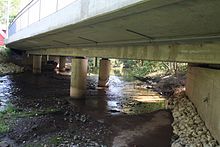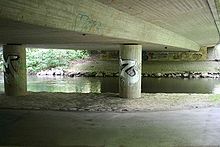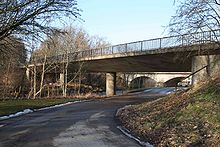List of Coburg bridges
The list of Coburg Bridges includes bridges that span the Itz in Coburg and large bridges with a total span of more than 100 meters.
Most of the bridge structures in Coburg, 62 pieces, are municipal and are maintained by the municipal company Coburg disposal and construction company CEB. The majority are smaller structures, for example over the Itz tributaries Lauter and Ketschenbach.
Itzbrücken
Of the 22 bridges over the Itz, two are railway overpass structures, five pedestrian walkways, a pipe bridge and the remaining 14 road bridges.
| bridge | Year of opening |
construction | image |
|---|---|---|---|
| Mühlenweg |
The bridge lies in the course of the Dörfles-Esbacher Mühlenweg and was built on the Friedrichsmühle as a western approach to the former Cortendorfer Porzellanfabrik Julius Griesbach (after 1973 the porcelain factory W. Goebel ). It crosses two lanes over the Itz, which forms the boundary between Coburg and Dörfles-Esbach . The two-span construction has steel main girders. |

|
|
| Cortendorfer Strasse |
1970s | The bridge in Cortendorfer Straße crosses two lanes and sidewalks on both sides. The single-span prestressed concrete structure has a five-web T- beam cross-section , which was produced with prefabricated parts. |

|
| Sheath |
The dilapidated steel bridge acts as a footbridge connecting the Scheidmantel brewery with the former ice ponds behind the brewery, between Itz and Hahnfluss. |

|
|
| Rosenauer Strasse |
1957/1973 | Originally there was a wooden bridge here, which was finally replaced by a massive bridge in 1957. But in 1971 the structure, which had become too small, was demolished and in 1973 the current bridge was built. The road bridge is curved in plan and crosses the Itz at an oblique angle. In 2008, 7,000 vehicles crossed the structure every day, which has two lanes and sidewalks on both sides. The three-span prestressed concrete construction has a single-web T-beam cross-section and four pillars with a massive circular cross-section. |

|
| Neudörfles |
The pedestrian bridge is located in the landscape park of the Neudörfles estate . It is a single-span wooden beam bridge. An Itzübergang is already recorded in the measurement table sheets of the Prussian state from 1906. |

|
|
| Causeway |
1968 | The single-span prestressed concrete bridge was built as part of the construction of the Dammweg, which connects Rosenauer Strasse with Neustadter Strasse. The structure has two lanes and a sidewalk on the side. The bridge replaced a wooden walkway for pedestrians. |

|
| Floßanger (pedestrian bridge) |
1988 | As part of the flood clearance of the section from Dammweg to Heiligkreuzbrücke from 1986 to 1988, the covered, single-span wooden truss bridge was built. |

|
| Heiligkreuzbrücke |
1398/1956 | In the Middle Ages, the trade route to Thuringia used a ford through the Itz at the site of today's bridge . A larger chapel, the later Holy Cross Church, was built there between 1401 and 1407 to honor a Holy Cross relic . In addition, a wooden walkway was built in 1398. In 1465, the first stone bridge in Coburg followed as a replacement structure, which was destroyed by floods in 1552. The reconstruction was completed in 1555. Under Duke Casimir , an arch bridge with four openings was built in 1618. The flood with ice in February 1784 severely damaged the bridge. In 1861, the bridge was widened by two sidewalks, and iron railings were installed as fall protection. Growing road traffic led to a further widening to 9 meters in 1893. In 1952 an emergency footbridge was built for pedestrians until the current bridge was opened to traffic in May 1956. It is a three-span reinforced concrete structure. 12,000 vehicles pass the structure every day. The structure, around 40 meters long and 16 meters wide, has three lanes and sidewalks on both sides. |

|
| Hohenlohebrücke (Bahnhofbrücke) |
1860/1959 | The Lange Steg, which was mentioned as early as 1670, was built next to a ford near the so-called Augustenstift. Floods and ice often destroyed the wooden structure. With the expansion of Bahnhofstrasse to connect the city to the train station in 1860/61, an 18 meter long and 7 meter wide bridge was built over the Itz. The iron lattice girders arranged laterally above the carriageway were supplied by the Erfurt machine works Christian Hagans . Due to a strong increase in traffic, the structure proved to be sensitive to vibrations and the wooden planking proved to be maintenance-intensive. This led to a new building at the beginning of the 20th century. The city architect Ehrich from Coburg designed the girder bridge, which had two laterally arranged iron trusses with curved upper chords and a roadway below. The company Louis Eilers from Hanover supplied the trusses, the construction company of Carl Otto Leheis received the order for the substructures. On October 19, 1901, the replacement building was inaugurated by its namesake, the then regent Ernst zu Hohenlohe-Langenburg . As part of the asphalting of Bahnhofstrasse, the bridge was raised by 60 centimeters in 1912. In 1959 the bridge, which was no longer sufficiently strong, was replaced by a new building. The reinforced concrete frame bridge, which is around 23 meters long and 15 meters wide, spans the Itz at an oblique angle. In the middle there is a 9 meter wide carriageway and 3 meter wide sidewalks on both sides. The structure has three lanes and sidewalks on both sides. |

|
| Mohren Bridge |
1876/1928 | As part of the western expansion of the city, Mohrenstrasse was built in the second half of the 19th century and, in 1876, the Mohrenbrücke as an Itz crossing. It was a lattice girder bridge with two laterally arranged trusses, parallel upper chords and a roadway below. A widening followed in 1904. In 1927 the builder Paul Schaarschmidt built a new bridge on behalf of the city, according to a plan by the Munich engineering office Streck & Zenß in cooperation with the Munich architect Prof. Jäger, which was opened to traffic in May 1928. It spans the Itz with an opening with a span of 21 meters and a total width of 15 meters, ten meters of which is the roadway. The first reinforced concrete bridge in Coburg consists of four frames arranged side by side, which are curved at the bottom like flat basket arches. The sidewalks on both sides are limited by massive parapets. At the western end of the bridge, upstream, there is a single-storey kiosk with a flat gable roof. This formerly housed a milk drinking hall and later a fruit and vegetable shop. A bridge figure is arranged downstream. The nude figure of a woman was created by Edmund Meusel and looks into the Itz. |

|
| Alexandrine Bridge |
1980 | The two-span T-beam bridge made of prestressed concrete was opened to traffic in 1980. The bridge has four lanes and walkways on both sides. The structure was built as part of the construction of the western bypass. The eastern swimming pool of the Ernst-Alexandrinen-Volksbad was demolished for this purpose. |

|
|
Jewish Bridge |
1470/1783 | The Judenbrücke is a brick arch bridge that spans the Itz with three openings. The current structure was erected in 1783 at the narrowest point of the Itz to replace a wooden bridge. The construction work was carried out by the timber builder Johann Michael Roeder and the stone builder Meier. In the following centuries, the building underwent several renovations to strengthen the structure and is still used today as a road bridge for local traffic. |

|
| Brockardt Bridge |
1891 | The Brockardt Bridge is an iron truss pedestrian walkway. The building was built by the Stuttgart company Christian Leins for the Coburg builder Bernhard Brockardt as a private footbridge and ceded to the city of Coburg in 1933. The construction of the trough bridge has iron trusses on both sides with riveted diagonal angle profiles and horizontal T-profiles. The bridge is 22.15 meters long and a total of four meters wide. The passage width is 2.82 meters. The building was renovated in 2014. The wooden planking was replaced by steel plates and the bridge mass was increased from 13.5 to 15 tons through reinforcement measures. |

|
| Frankenbrücke |
1993 | The T-beam bridge made of prestressed concrete spans the Itz, Werra Railway and Bundesstraße 4 at Hofbräuhaus. The main bridge with four lanes and sidewalks on both sides has a total span of 178.99 meters. The spans of the five fields are 37.48 meters, 29.16 meters, 29.16 meters, 33.79 meters and 49.40 meters. The two ramp bridges parallel to the main road have three fields with a total span of 78.95 meters and four fields with a total span of 103.96 meters. |

|
| Ketschenbrücke (Schlachthofbrücke) |
1405/1958 | The bridge spans the Itz at the Coburg slaughterhouse . An "oak bridge" was first mentioned in 1405. The wooden structure was also called the "oak bridge". A stone bridge followed in 1780. Building materials were mainly sandstones from the city wall. In November 1901 a new iron truss bridge followed with two laterally arranged truss girders and a roadway below. At the end of 1958, the bridge from 1901 was replaced by a reinforced concrete frame bridge. The structure, which is around 21 meters long and 16 meters wide, spans the Itz at a height of around 5 meters at an oblique angle. In the middle there is a 9 meter wide roadway, as well as sidewalks on both sides. Originally both sidewalks were 3.5 meters wide. As part of the construction of the neighboring Franconian Bridge, the upstream cantilever slab with the walkway was reduced to about 1 meter wide. |

|
| slaughterhouse |
The steel pipe bridge served to supply the Coburg slaughterhouse. |

|
|
| SÜC bridge |
1950 | As early as 1907, after the construction of the freight yard , a siding with an Itz bridge was planned for the municipal gas works in Uferstraße. However, the connection was only implemented in 1950 and simplified the supply of coal to the gas works. The route was operated by an in-house diesel locomotive. In 1990 the connection was dismantled, the bridge was preserved. In the area of the Itzbrücke the railway line is curved in plan, with the oblique angled bridge having a straight construction. |

|
| Ernst Faber Bridge |
2017 | The Ernst Faber Bridge was built in 2017. The road bridge, which costs 2.7 million euros, serves to develop the former freight yard area. The prestressed concrete bridge is 15.5 meters wide and has a span of around 26 meters. The foundation of the two abutments rests on 17 bored piles. |

|
| Cross bridge |
2011 | The Brosesteg was built in November 2011 by Brose Fahrzeugteile . The pedestrian walkway connected Plant 2 with the site of the former freight yard, where the company had set up parking spaces for its employees. The bridge had a span of around 30.5 meters and a deck width of 2.2 meters. After the Ernst Faber Bridge went into operation, the temporary bridge, a so-called Bailey Bridge , was dismantled in 2018. |

|
| Sheep footbridge |
1431/1902 | The Schafsteg leads along the Wassergasse from Ketschendorf towards Ahorn over the Itz. The structure replaces an old ford. A wooden footbridge, the Ketschensteg, is documented for the year 1431. In 1725 the pedestrian bridge was called the Schafsteg. On March 1, 1830, a flood destroyed the structure. In the course of the expansion of today's Wassergasse into a promenade, initiated by Duke Ernst I , a new, passable Schafstegbrücke was built in 1836. It was an arch bridge made of sandstone masonry, which had a large opening and two small flood openings on the left. The building cost 1136 guilders and 38 cruisers. On February 28, 1900, the bridge collapsed due to structural damage. In 1901 a new iron girder bridge was built, which was opened to traffic on February 1, 1902. The flood of February 5, 1909 undermined the bridge foundations and caused a partial collapse. At a cost of DM 20,000, the bridge was placed half a meter higher as part of the repair and two flood passages were added on the eastern bank. The structure was approved for vehicles with a mass of nine tons. In 1964, a reinforced concrete deck was installed for 70,000 DM to increase the load-bearing capacity to 16 tons. Since then, the Schafsteg has a 5 meter wide roadway and narrow sidewalks on both sides. The 19.2 meter long main opening is spanned with two laterally arranged steel lattice girders with curved upper chords and a roadway below. The flood openings are bridged by a reinforced concrete slab with spans of 5.8 meters and 5.92 meters and the continuous beam as a structural system in the longitudinal direction. |

|
| Itzbrücke of the Werra Railway |
1858/1911 | The railway overpass structure at route km 132.50 dates from 1927. It was originally built in 1858 and was widened in 1911 as part of the double-track line expansion between Creidlitz and the freight station. The 51 meter long vaulted bridge has three openings. |

|
| Itzbrücke of Bundesstrasse 4 |
1963 | The three-span reinforced concrete slab bridge was built as part of the construction of the western bypass of the Coburg city center in the early 1960s. It crosses two lanes of federal highway 4. |

|
Large bridges
In Coburg there are three bridges with a total span of more than 100 meters in connection with Bundesstraße 4. In addition to the Frankenbrücken, which spans the Itz, there are the southern access to Coburg and the Callenberg bridge. In addition, there is a long railway overpass structure, the Kiengrund Bridge , in the Seidmannsdorf district .
Road bridges
| bridge | Year of opening |
construction | image |
|---|---|---|---|
| South approach to Coburg |
1970 | The ramp structure in the course of Bamberger Straße has a lane in each direction and connects Bundesstraße 4 with the south of Coburg. For this purpose, the prestressed concrete bridge spans the tracks of the Werra Railway and, with the western ramp, in the direction of Bamberg, also the federal road. This part of the bridge is 163.4 meters long, with four fields with spans of 22.1 meters and three fields with 25 meters. The eastern ramp with the direction of travel Coburg is 88.4 meters long and has four fields with spans of 22.1 meters. |

|
| Callenberg Bridge |
1981 | The structure crosses Bundesstraße 4 with two lanes in each direction and is located in the course of Adamisstraße. The bridge spans the Lauter and Callenberger Strasse at an oblique angle. The girder bridge made of prestressed concrete has an eastern superstructure with two spans, each with a span of 56.6 meters, and a western superstructure with three openings and spans of 55.27 meters, 57.56 meters and 29.6 meters, resulting in a total span of 142, 43 meters. The construction height is a uniform 2.0 meters. The massive central pillars have a circular cross-section with a diameter of 2.0 meters. |

|
Railway bridge
| bridge | Year of completion |
construction | image |
|---|---|---|---|
| Kiengrund Bridge |
2013 | The bridge of the high-speed line Nuremberg – Erfurt spans the Kiengrund at a height of about 12 meters. The 108 meter long structure is a single span girder chain and consists of four separate pre- stressed concrete superstructures. The girders have a single-web T- beam cross - section and spans of 24 meters for the end spans and 30 meters for the inner spans. |

|
literature
- Peter Morsbach, Otto Titz: City of Coburg. Ensembles-Architectural Monuments-Archaeological Monuments . Monuments in Bavaria. Volume IV.48. Karl M. Lipp Verlag, Munich 2006, ISBN 3-87490-590-X
- Harald Sandner: Coburg in the 20th century. The chronicle of the city of Coburg and the House of Saxe-Coburg and Gotha from January 1, 1900 to December 31, 1999 - from the "good old days" to the dawn of the 21st century. Against forgetting . New Press Publishing House, Coburg 2002, ISBN 3-00-006732-9
Individual evidence
- ^ New Press Coburg, May 9, 2009
- ↑ a b Georg Aumann, Karl-Ulrich Pachale: The Itz . Series of publications of the historical society Coburg e. V. Volume 15. ISSN 0947-0344
- ↑ coburg-life.de Die Brücke in Cortendorf , May 11, 2009
- ↑ Christian Boseckert: Die Heiligkreuzbrücke , coburg-life.de, September 13, 2009
- ^ Coburger Zeitung, October 20, 1901
- ^ A b c Walter Landefeld: The history of the Jewish bridge in Coburg . In: Heimatkundliche Lesebogen für das Coburger Land, No. 9–12, December 1973, pp. 41–43.
- ↑ Federal Ministry of Transport: Bridges on federal highways 1995 . Verkehrsblatt Verlag 1995, ISBN 3-89273-072-5 , pp. 61-70
- ↑ Städtische Werke · Überlandwerke · Coburg: 100 years of gas, 60 years of water, 50 years of electricity. Coburg 1954.
- ↑ Steffen Dietsch, Stefan Goldschmidt, Hans Löhner: The Werrabahn . Verlag Eisenbahnfreunde Steinachtalbahn-Coburg, Coburg 2008, ISBN 978-3-9810681-3-9 , p. 84.
- ↑ Dywidag reports, No. 7, Prestressed Concrete Bridges, pp. 32–33